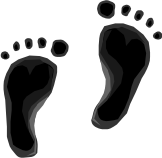The reasons for carrying out a pedicure are as follows
- To make the feet more attractive
- To reduce the amount of hard skin
- To relax tired aching feet
Pedicure Equipment and Materials Checklist
- Small bowls lined with tissue for jewellery
- Small bowl lined with tissue for cotton pads/buds
- Black file
- Buffer
- Orange wood stick
- Cuticle knife
- Hoof stick
- Nail scissors/clippers
- Foot Spa with warm water and soak
- Cuticle Remover
- Foot rasp and exfoliating scrub
- Cuticle cream
- Cuticle nippers
- Cotton wool
- Cotton Buds
- Water in a dish for cuticle knife work
- Antiseptic
- Alcohol
- Base Coat
- Selection of nail enamels
- Top Coat
- Foot Cream/Oil
- Tissues
- Client record card

Prepare the equipment neatly on a trolley so that everything you need is to hand, and the client need not be disturbed during the treatment.
Place a towel on the floor between you and the client. The foot spa containing warm soapy water should be placed on this towel.
Towels should be placed on your lap; one is for your protection and the other is for drying the client’s feet. Keep the other towels close by for wrapping the client’s feet, after mask or massage.
Ensure that the client has a comfortable chair at the correct height, so that you and the client are both comfortable. Before treatment begins, ask the client to remove their tights or socks, and any clothing that might restrict their lower leg movement, such as jeans or trousers. Cover their upper legs with a clean towel. This will help them to be more comfortable and allow you to work without restriction. Discuss the treatment with the client to discover their needs and record them on the client card.
Toenails should be cut straight across; using nail clippers or strong sharp scissors, then filed smooth using a file with 240 grit. Catch all clippings in a tissue and put straight into the bin.
Hard skin develops on the feet as a form of protection, either from friction from footwear or from standing for long periods of time. It is therefore not advisable to remove all the hard skin from an area, as this would remove the protective pad. Hard skin should be removed only to improve the appearance of the feet. Hard skin buildup that causes pain or discomfort should be referred to a podiatrist.
Excess hard skin is removed with abrasive pastes, pumice stones, foot rasps, podiatrist sponges and corn planes. Abrasive pastes should be used with a deep circular massage movement. They are ideal when only a very small buildup of hard skin is present. Files, pumice stones and the rest should be used with a swift stroking movement in one direction only. Sawing back and forth would lead to friction and discomfort for the client. Always finish off a hard skin removal procedure with a lot of moisturizer or hand cream to soften the newly exposed skin.
As with a manicure massage, the pedicure massage is carried out near the end of the treatment, prior to nail enameling. The pedicure massage includes the foot and the lower leg and offers benefits to the client comparable with those of the manicure.